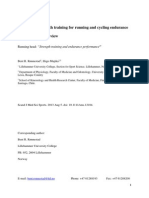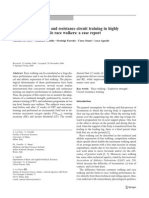Gross Efficiency Is Improved in Standing Position With An Increase of The Power Output
Gross Efficiency Is Improved in Standing Position With An Increase of The Power Output
Uploaded by
CristianLopezCopyright:
Available Formats
Gross Efficiency Is Improved in Standing Position With An Increase of The Power Output
Gross Efficiency Is Improved in Standing Position With An Increase of The Power Output
Uploaded by
CristianLopezOriginal Title
Copyright
Available Formats
Share this document
Did you find this document useful?
Is this content inappropriate?
Copyright:
Available Formats
Gross Efficiency Is Improved in Standing Position With An Increase of The Power Output
Gross Efficiency Is Improved in Standing Position With An Increase of The Power Output
Uploaded by
CristianLopezCopyright:
Available Formats
2nd World Congress of Cycling Science, 2nd and 3rd July 2014, Leeds
J Sci Cycling. Vol. 3(2), 6
BOOK OF ABSTRACTS
Open Access
Gross efficiency is improved in standing
position with an increase of the power output
A Bouillod , J Pinot
1
1, 2
A Valade J Cassirame G Soto-Romero and F Grappe
1, 2
Abstract
Background: Gross efficiency (GE) has been shown to be one of the most relevant parameter influencing cycling
performance but to the best of our knowledge, just one study focused on measuring GE in seated and standing
positions during field conditions (Millet et al., 2002: Medicine & Science in Sports & Exercise, 34(10), 1645-52).
Other authors investigated the effects of change in body position (seated vs. standing) on energy expenditure, heart
rate (HR) or pulmonary ventilation (VE) but there were large changes in the results (Ryschon & Stray-Gundersen,
1991: Medicine & Science in Sports & Exercise, 23, 949-953; Swain & Wilcox, 1992: Medicine & Science in Sports &
Exercise, 24, 1123-1127) due to the different protocols. Indeed, the cross effect of slope and intensity on GE in
standing compared to seated position has not been studied. Thus, we found interesting to measure GE in real
locomotion with elite cyclists at different intensities and slopes.
Purpose: This study was designed to examine the effects of standing position on GE compared to seated position at
different intensities and slopes.
Methods: After a period of familiarisation, 13 elite participants performed on a motorised treadmill with their own bike
one session during which they rode in a randomized order seated vs. standing positions with several slopes (5, 7.5
-1
and 10%) and intensities (3.8, 4.2 and 4.6 W.kg ). GE was calculated for each condition using the ratio of power
output (PO) measured with a Powertap G3 hub (CycleOps, Madison, USA) and the oxygen uptake (VO2) measured
with a portable gas analyzer (Metamax 3B, Cortex, Leipzig, Germany).
Results: GE was significantly higher (+4.5%) in standing position (21.5 5.2 %, CV = 5.2%) compared to seated
position (20.6 1.1 %, CV = 5.5%) for all the intensities and slopes. This improvement was due to a significant (p <
0.001) increase of PO in standing position (+4.5%) associated with a stabilization of VO2. The more the slope was
low and the intensity was high, the more the pedaling cadence was high. That leads to higher PO changes between
standing and seated positions (R = 0.93, p < 0.001) (Figure 1).
Discussion: The main finding of this study shows that in standing position, GE was increased from a higher PO. The
non-significant increase in VO2 is in accordance with the previous results of Millet et al. (2002). It's the first time that
a study shows an increase in PO in standing position. The difference in PO is linked to an increase of the pedaling
cadence. We hypothesize that the increase in PO is due to the technique adopted in standing position, the latter has
an impact on the mechanical deformation both of the tires and the bike frame. The loss of energy in the bike and the
tires would require to increase the PO in standing position according to the technique of each cyclist.
Conclusion: Despite a significant decrease of GE, the standing position involves a significant increase in PO
probably due to an increase of the deformation of both the tires and the bike frame according to the pedaling
techniques of the cyclist.
Contact email: anthonybouillod@gmail.com (A.
Bouillod)
1
EA4660, C3S Health - Sport Department, Sports University,
Besancon, France.
2
Professional Cycling Team FDJ.fr
LAAS-CNRS, Toulouse, France
__________________________________________________
Received: 1 May 2014. Accepted: 1 June 2014.
2014 2nd World Congress of Cycling Science, 2nd and 3rd July 2014, Leedst; licensee JSC. This is an Open Access article distributed under the
terms of the Creative Commons Attribution License (http://creativecommons.org/licenses/by/3.0/), which permits unrestricted use, distribution, and
reproduction in any medium, provided the original work is properly cited.
You might also like
- Undateable 1x01 - PilotDocument56 pagesUndateable 1x01 - Pilotkinghall2891No ratings yet
- Alouette Models, 1967-1976Document5 pagesAlouette Models, 1967-1976Paul MartinNo ratings yet
- Drilling Machine ReportDocument38 pagesDrilling Machine ReportPraveen Mathias80% (15)
- Accepted: Mechanisms For Improved Running Economy in Beginner RunnersDocument27 pagesAccepted: Mechanisms For Improved Running Economy in Beginner RunnersmadloloNo ratings yet
- Changes in Lactate Kinetics Underpin Soccer Performance Adaptations To Cycling Based Sprint Interval TrainingDocument10 pagesChanges in Lactate Kinetics Underpin Soccer Performance Adaptations To Cycling Based Sprint Interval TrainingJorge Rubio LópezNo ratings yet
- The Reliability of Cycling EfficiencyDocument7 pagesThe Reliability of Cycling EfficiencyFabian Rodriguez LopezNo ratings yet
- Physiological Demands of Trampolining at Different IntensitiesDocument7 pagesPhysiological Demands of Trampolining at Different IntensitiesTane ClementNo ratings yet
- Effects of A Seven Day Period of High-Intensity Training On Performance and Physiology of Competitive CyclistsDocument1 pageEffects of A Seven Day Period of High-Intensity Training On Performance and Physiology of Competitive CyclistsCristianLopezNo ratings yet
- The Relationship Between Running Power and RunningDocument10 pagesThe Relationship Between Running Power and RunningDario GerpeNo ratings yet
- Joint Kinematics Assessment During Cycling Incremental Test To ExhaustionDocument7 pagesJoint Kinematics Assessment During Cycling Incremental Test To ExhaustionFábio LanferdiniNo ratings yet
- Articulo FTPDocument10 pagesArticulo FTPCristianLopezNo ratings yet
- Effect of Environmental Temperature On Pacing During A Simulated 16 KM Cycling Time TrialDocument1 pageEffect of Environmental Temperature On Pacing During A Simulated 16 KM Cycling Time TrialCristianLopezNo ratings yet
- Kayihan Et Al. 2013Document3 pagesKayihan Et Al. 2013Taha IliasNo ratings yet
- Strength Training and Endurance Performance - ResearchGateDocument27 pagesStrength Training and Endurance Performance - ResearchGateCristianLopezNo ratings yet
- Fspor 04 860685Document7 pagesFspor 04 860685SportsciencesNo ratings yet
- Investigating The Effect of Bouncing Type On The Physiological Demands of TrampoliningDocument7 pagesInvestigating The Effect of Bouncing Type On The Physiological Demands of TrampoliningTane ClementNo ratings yet
- Bulthuis 2021 Outdoor e Trike Cycling A Low IntenDocument9 pagesBulthuis 2021 Outdoor e Trike Cycling A Low Inten01fe19bme079No ratings yet
- 2021 - Beta-alanine did not improve high-intensity performance throughout simulated road cyclingDocument11 pages2021 - Beta-alanine did not improve high-intensity performance throughout simulated road cyclingAugusto AraújoNo ratings yet
- Biomechanical Measures of Short-Term MaximalDocument20 pagesBiomechanical Measures of Short-Term MaximalFateen IrwahandNo ratings yet
- Utility of The W BAL Model in Training Programme Design For Masters CyclistsDocument11 pagesUtility of The W BAL Model in Training Programme Design For Masters CyclistsMiguel Angel Galán RiojaNo ratings yet
- Training Intensity Distribution Analysis by Race Pace vs. Physiological Approach in World-Class Middle - and Long-Distance RunnersDocument9 pagesTraining Intensity Distribution Analysis by Race Pace vs. Physiological Approach in World-Class Middle - and Long-Distance RunnersultraminingNo ratings yet
- PTJ 1188Document8 pagesPTJ 1188asutosh patroNo ratings yet
- Mawlana 'Ali Ibn Husain Safi, Muhtar Holland - Beads of Dew From The Source of Life (Rashahat 'Ayn Al-Hayat) - Al-Baz Publishing, Inc. (2001)Document9 pagesMawlana 'Ali Ibn Husain Safi, Muhtar Holland - Beads of Dew From The Source of Life (Rashahat 'Ayn Al-Hayat) - Al-Baz Publishing, Inc. (2001)Marcelo Da SilvaNo ratings yet
- Training Intensity Distribuition Analysis by Race Pace Vs Physiological Approach in World-Class Middle - and Long-Distance RunnersDocument24 pagesTraining Intensity Distribuition Analysis by Race Pace Vs Physiological Approach in World-Class Middle - and Long-Distance Runnersgines.gonzalez.umhNo ratings yet
- Breil Et Al. (2010) - Block Periodization in Alpine Skiing - Effects of 11 Day HIT On VO2max and PerformanceDocument10 pagesBreil Et Al. (2010) - Block Periodization in Alpine Skiing - Effects of 11 Day HIT On VO2max and PerformanceAnaNo ratings yet
- HandbikeDocument10 pagesHandbikeLely JuniariNo ratings yet
- HandbikeDocument10 pagesHandbikeLely JuniariNo ratings yet
- Strength Training Improves Cycling Performance, Fractional Utilization of VO and Cycling Economy in Female CyclistsDocument13 pagesStrength Training Improves Cycling Performance, Fractional Utilization of VO and Cycling Economy in Female CyclistsLuis TrottaNo ratings yet
- Rønnestad Mujika Review Strenght Training Endurance AthletesDocument10 pagesRønnestad Mujika Review Strenght Training Endurance AthletesGiacomoCarlucciNo ratings yet
- Laforgia 1997Document7 pagesLaforgia 1997volmedo28No ratings yet
- Biomechanical Mechanism of Peak Braking Force Modulation During Increased Walking Speed in Healthy Young Adults (2022)Document15 pagesBiomechanical Mechanism of Peak Braking Force Modulation During Increased Walking Speed in Healthy Young Adults (2022)Maria Paula Lopez UribeNo ratings yet
- Combined Endurance and Resistance Circuit Training in Highly Trained/top-Level Female Race Walkers: A Case ReportDocument9 pagesCombined Endurance and Resistance Circuit Training in Highly Trained/top-Level Female Race Walkers: A Case ReportmanrunnerNo ratings yet
- 10 1016@j Jbiomech 2019 109474Document25 pages10 1016@j Jbiomech 2019 109474joaovcfNo ratings yet
- ARTICLE-Effects of A Wheelchair Ergometer Training Programme On SpinalDocument6 pagesARTICLE-Effects of A Wheelchair Ergometer Training Programme On SpinalavalosheNo ratings yet
- Goulet, 2011 - Effect of Exercise-Induced Dehydration On Time-Trial Exercise Performance. A Meta-AnalysisDocument9 pagesGoulet, 2011 - Effect of Exercise-Induced Dehydration On Time-Trial Exercise Performance. A Meta-Analysisailbhe96No ratings yet
- 10% Higher Rowing Power Outputs After Flexion-Extension-Cycle Compared To An Isolated Concentric Contraction in Sub-Elite RowersDocument7 pages10% Higher Rowing Power Outputs After Flexion-Extension-Cycle Compared To An Isolated Concentric Contraction in Sub-Elite Rowerswisexaf310No ratings yet
- Effects of Respiratory Resistance Training With A Concurrent Flow Device On Wheelchair AthletesDocument8 pagesEffects of Respiratory Resistance Training With A Concurrent Flow Device On Wheelchair AthletesN onlyNo ratings yet
- Physiological Responses and Predictors of Performance in A SimulatedDocument8 pagesPhysiological Responses and Predictors of Performance in A SimulatedAdy TaikoNo ratings yet
- Relationship Between Leg Length and Trunk Orientation in CyclingDocument1 pageRelationship Between Leg Length and Trunk Orientation in CyclingCristianLopezNo ratings yet
- Scandinavian Med Sci Sports - 2020 - Kordi - Cycling Specific Isometric Resistance Training Improves Peak Power Output inDocument11 pagesScandinavian Med Sci Sports - 2020 - Kordi - Cycling Specific Isometric Resistance Training Improves Peak Power Output inEduarda Vicari SilvaNo ratings yet
- Lanferdini Et Al. 2020 - RBE PDFDocument10 pagesLanferdini Et Al. 2020 - RBE PDFFábio LanferdiniNo ratings yet
- Effects of Specific Versus Cross-TraininDocument7 pagesEffects of Specific Versus Cross-TraininManoella SilvaNo ratings yet
- Muscle Coordination Patterns For Efficient Cycling.21Document13 pagesMuscle Coordination Patterns For Efficient Cycling.21raduNo ratings yet
- Physiological Responses To The Alterg Anti-Gravity TreadmillDocument6 pagesPhysiological Responses To The Alterg Anti-Gravity TreadmillAnonymous b2k9ABe7eNo ratings yet
- Travis Et Al 2020 Weight Selection Attempts of Elite Classic PowerliftersDocument15 pagesTravis Et Al 2020 Weight Selection Attempts of Elite Classic PowerliftersJosh InmanNo ratings yet
- Nutrition For Endurance Sports Marathon, Triathlon, PDFDocument10 pagesNutrition For Endurance Sports Marathon, Triathlon, PDFSheilla ElfiraNo ratings yet
- Acute Effects of Small Changes in BicyclDocument8 pagesAcute Effects of Small Changes in BicyclcsrpirataNo ratings yet
- Pedaling Confusion: Methods That Lack Sound Basis Show How Not To Train IndoorsDocument3 pagesPedaling Confusion: Methods That Lack Sound Basis Show How Not To Train IndoorsLeonardoValenzuelaNo ratings yet
- Exercise Discussion and ConclusionDocument2 pagesExercise Discussion and Conclusionamogelangsekhu94No ratings yet
- The Effect of Alanine Supplementation On Cycling Time Trials of Different LengthDocument9 pagesThe Effect of Alanine Supplementation On Cycling Time Trials of Different Lengthgriego81No ratings yet
- Block Periodization of High-Intensity Aerobic Intervals Provides Superior Training Effects in Trained CyclistsDocument9 pagesBlock Periodization of High-Intensity Aerobic Intervals Provides Superior Training Effects in Trained Cyclistsأحمد ابراهيمNo ratings yet
- Padulo JSCR2012 KinematicsofrunningatdifferentslopesandspeedsDocument9 pagesPadulo JSCR2012 KinematicsofrunningatdifferentslopesandspeedsFrançois LE GUENNo ratings yet
- Scandinavian Med Sci Sports - 2020 - Kordi - Cycling Specific Isometric Resistance Training Improves Peak Power Output inDocument11 pagesScandinavian Med Sci Sports - 2020 - Kordi - Cycling Specific Isometric Resistance Training Improves Peak Power Output inmarcoscedrazNo ratings yet
- 2013 BERTUZZI Energy System Contributions During Incremental Exercise TestDocument7 pages2013 BERTUZZI Energy System Contributions During Incremental Exercise TestEduardo de SouzaNo ratings yet
- CpetDocument16 pagesCpetFaizal AblansahNo ratings yet
- Cycling and Sprinting BiomechanicsDocument42 pagesCycling and Sprinting BiomechanicsAraya ThimlamomNo ratings yet
- Different Effect of Cadaence On Cycling Efficiency Between Young and AdultsDocument6 pagesDifferent Effect of Cadaence On Cycling Efficiency Between Young and AdultsnirchennNo ratings yet
- Intense Training - The Key To Optimal Performance Before and During The TaperDocument8 pagesIntense Training - The Key To Optimal Performance Before and During The Tapersara_damato10No ratings yet
- CHO + PRO Antes Do Ciclismo 2011 - Amanda ScagnolatoDocument11 pagesCHO + PRO Antes Do Ciclismo 2011 - Amanda ScagnolatoMagno FilhoNo ratings yet
- Ijsnem Article p636Document7 pagesIjsnem Article p636363331272No ratings yet
- Duncan 2018Document10 pagesDuncan 2018Santiago PonceNo ratings yet
- A Field-Based Cycling Test To Assess Predictors of Endurance Performance and Establishing Training Zones - DAJO - SANDERSDocument22 pagesA Field-Based Cycling Test To Assess Predictors of Endurance Performance and Establishing Training Zones - DAJO - SANDERSdaniellopes.tvrNo ratings yet
- The Effect of Wheel Diameter On Vertical and Horizontal Mountain Bike PositionDocument1 pageThe Effect of Wheel Diameter On Vertical and Horizontal Mountain Bike PositionCristianLopezNo ratings yet
- 44 - 2WCSCDocument1 page44 - 2WCSCCristianLopezNo ratings yet
- 41 - 2WCSCDocument1 page41 - 2WCSCCristianLopezNo ratings yet
- Comparing Time-Trial and Time To Exhaustion Performance: Book of AbstractsDocument1 pageComparing Time-Trial and Time To Exhaustion Performance: Book of AbstractsCristianLopezNo ratings yet
- Effect of Environmental Temperature On Pacing During A Simulated 16 KM Cycling Time TrialDocument1 pageEffect of Environmental Temperature On Pacing During A Simulated 16 KM Cycling Time TrialCristianLopezNo ratings yet
- 35 - 2WCSCDocument1 page35 - 2WCSCCristianLopezNo ratings yet
- Measures of Training Stress in Cyclists Do Not Usefully Predict Maximum Mean Power in CompetitionsDocument1 pageMeasures of Training Stress in Cyclists Do Not Usefully Predict Maximum Mean Power in CompetitionsCristianLopezNo ratings yet
- Relation Between Lactic Acid Steady-State and Muscle Oxygenation in Elite CyclistsDocument3 pagesRelation Between Lactic Acid Steady-State and Muscle Oxygenation in Elite CyclistsCristianLopezNo ratings yet
- Do 3-Min All-Out Test Parameters Accurately Predict Competitive Cyclist Performance in The Severe Intensity Domain?Document1 pageDo 3-Min All-Out Test Parameters Accurately Predict Competitive Cyclist Performance in The Severe Intensity Domain?CristianLopezNo ratings yet
- 26 - 2WCSCDocument1 page26 - 2WCSCCristianLopezNo ratings yet
- Modelling of Critical Power From Road DataDocument2 pagesModelling of Critical Power From Road DataCristianLopezNo ratings yet
- 20 - 2WCSCDocument1 page20 - 2WCSCCristianLopezNo ratings yet
- Past Attempts To Identify A Single Physiological Parameter As The Main Indicator of Success in The Tour de France Seem To Have FailedDocument2 pagesPast Attempts To Identify A Single Physiological Parameter As The Main Indicator of Success in The Tour de France Seem To Have FailedCristianLopezNo ratings yet
- Relationship Between Leg Length and Trunk Orientation in CyclingDocument1 pageRelationship Between Leg Length and Trunk Orientation in CyclingCristianLopezNo ratings yet
- The Analysis & Forecasting of British Cycling Time Trial RecordsDocument1 pageThe Analysis & Forecasting of British Cycling Time Trial RecordsCristianLopezNo ratings yet
- Individualised Training Duration Induces Similar Physiological and Performance Benefits at Different IntensitiesDocument1 pageIndividualised Training Duration Induces Similar Physiological and Performance Benefits at Different IntensitiesCristianLopezNo ratings yet
- E-MobilitySolutions - EN - 2021 Double Page ViewDocument106 pagesE-MobilitySolutions - EN - 2021 Double Page ViewVlad StanescuNo ratings yet
- Liveable CityDocument4 pagesLiveable CityaffansyahNo ratings yet
- Suspension Setup Guide: Document ContentsDocument7 pagesSuspension Setup Guide: Document ContentsAlex RusenNo ratings yet
- Cycling Weekly 11 01 2024Document64 pagesCycling Weekly 11 01 20241feaster902No ratings yet
- Physical Work Capacity TestDocument3 pagesPhysical Work Capacity TestSoya Asakura0% (1)
- Specialized Preisliste Mountainbike 2013Document4 pagesSpecialized Preisliste Mountainbike 2013Timothy JacksonNo ratings yet
- The Running CycleDocument4 pagesThe Running CycleFran AriasNo ratings yet
- T2800 Extra Instructions Mounting CassetteDocument2 pagesT2800 Extra Instructions Mounting CassetteValentin BeatoNo ratings yet
- Dingo Bo PDFDocument11 pagesDingo Bo PDFAldi Pranata100% (1)
- Electric Scooter ManualDocument22 pagesElectric Scooter ManualDavid Kane100% (1)
- March 15 Press ReleaseDocument2 pagesMarch 15 Press ReleasePeter PotrebicNo ratings yet
- The Art of RollerskiingDocument91 pagesThe Art of RollerskiingDavid George100% (1)
- Listino Bici Giant e Liv 2018Document2 pagesListino Bici Giant e Liv 2018Veronica MicozziNo ratings yet
- Hobbies Present Simple and Present Continuous, Poziom A2, Damian KupiszDocument6 pagesHobbies Present Simple and Present Continuous, Poziom A2, Damian KupiszDamian KupiszNo ratings yet
- 2013 Truvativ SPC Rev B PDFDocument22 pages2013 Truvativ SPC Rev B PDFQuadalertNo ratings yet
- Eneos Gp4t Ultra Enduro 15w50 Fully Synthetic With EstersDocument1 pageEneos Gp4t Ultra Enduro 15w50 Fully Synthetic With Estersdan0410No ratings yet
- Mlremas 05 17-0290 2018Document20 pagesMlremas 05 17-0290 2018Cristi CristiNo ratings yet
- Infiniti QX70 EuroNCAP PDFDocument3 pagesInfiniti QX70 EuroNCAP PDFcarbasemyNo ratings yet
- PP 2011 Street USDocument84 pagesPP 2011 Street USandres_1109No ratings yet
- Recent Trends in Tyre TechnologyDocument22 pagesRecent Trends in Tyre TechnologyRahul100% (1)
- Motoroids2 April 2010Document66 pagesMotoroids2 April 2010Amit ChhanganiNo ratings yet
- Op Essential 10 TransportDocument2 pagesOp Essential 10 TransportHang DuongNo ratings yet
- Australian Mountain Bike 211 - 2024 AUDocument132 pagesAustralian Mountain Bike 211 - 2024 AUspleefomaniacNo ratings yet
- My21 Mountain Bike Geometry: Twostroke 01 2 Twostroke Al 3Document9 pagesMy21 Mountain Bike Geometry: Twostroke 01 2 Twostroke Al 3emiliano_387665009No ratings yet
- FINAL Ulster Combined Report From STONE 12-15Document104 pagesFINAL Ulster Combined Report From STONE 12-15Watershed PostNo ratings yet
- Analyse Unfamiliar Text Practice QuestionsDocument20 pagesAnalyse Unfamiliar Text Practice Questionsapi-293260528No ratings yet
- Redway Design Manual Consultation DraftDocument51 pagesRedway Design Manual Consultation DraftHoang Ngoc Hieu NguyenNo ratings yet







































































































